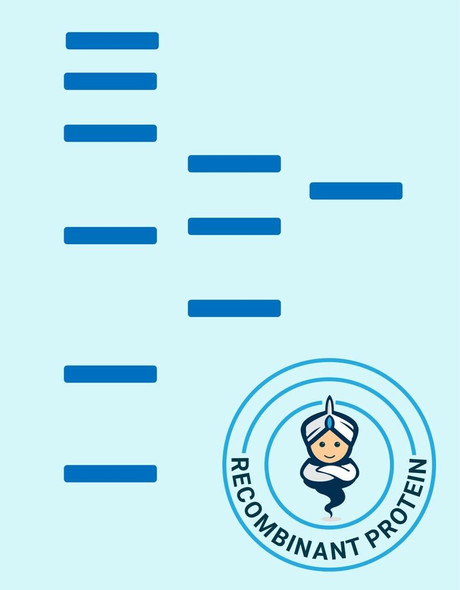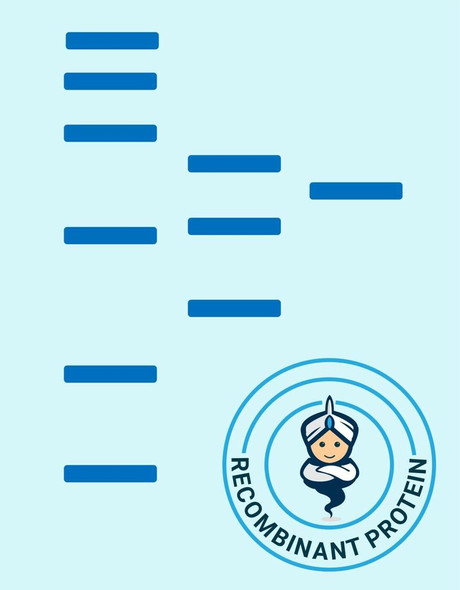Description
| Product Name: | Human KRT20 Recombinant Protein |
| Product Code: | RPPB3821 |
| Size: | 20µg |
| Species: | Human |
| Target: | KRT20 |
| Synonyms: | Keratin type I cytoskeletal 20, Cytokeratin-20, CK-20, Keratin-20, K20, Protein IT, KRT20, CD20, CK20, KRT21, MGC35423. |
| Source: | Escherichia Coli |
| Physical Appearance: | Sterile Filtered White lyophilized (freeze-dried) powder. |
| Formulation: | The protein (1mg/1ml) was lyophilized after from a sterile solution containing 30mM Tris-HCL pH-8, 9.5M urea, 2mM DDT, 2mM EDTA and 10mM methylammonium chloride. |
| Solubility: | It is recommended to reconstitute the lyophilized KRT20 in sterile 18M?-cm H2O not less than 100�g/ml, which can then be further diluted to other aqueous solutions. |
| Stability: | Lyophilized KRT20 although stable at room temperature for 3 weeks, should be stored desiccated below -18°C. Upon reconstitution KRT20 should be stored at 4°C between 2-7 days and for future use below -18°C.For long term storage it is recommended to add a carrier protein (0.1% HSA or BSA).Please prevent freeze-thaw cycles. |
| Purity: | Greater than 95.0% as determined by SDS-PAGE. |
KRT20 is a member of the keratin family. The keratins are intermediate filament proteins responsible for the structural integrity of epithelial cells and are subdivided into cytokeratins and hair keratins. The type I cytokeratins consist of acidic proteins which are arranged in pairs of heterotypic keratin chains. This cytokeratin is a major cellular protein of mature enterocytes and goblet cells and is specifically expressed in the gastric and intestinal mucosa. The type I cytokeratin genes are clustered in a region of chromosome 17q12-q21.
Cytokeratin 20 Human Recombinant produced in E.Coli is a single,non-glycosylated polypeptide chain having a molecular mass of 48,553 Dalton. The KRT20 is purified by proprietary chromatographic techniques.
| UniProt Protein Function: | Function: Plays a significant role in maintaining keratin filament organization in intestinal epithelia. When phosphorylated, plays a role in the secretion of mucin in the small intestine |
| UniProt Protein Details: | By similarity. Ref.4 Ref.8 Subunit structure: Heterotetramer of two type I and two type II keratins. Associates with KRT8. Subcellular location: Cytoplasm Ref.6 Ref.7. Tissue specificity: Expressed predominantly in the intestinal epithelium. Expressed in luminal cells of colonic mucosa. Also expressed in the Merkel cells of keratinized oral mucosa; specifically at the tips of some rete ridges of the gingival mucosa, in the basal layer of the palatal mucosa and in the taste buds of lingual mucosa. Ref.6 Ref.7 Developmental stage: First detected at embryonic week 8 in individual 'converted' simple epithelial cells of the developing intestinal mucosa. In later fetal stages, synthesis extends over most goblet cells and a variable number of villus enterocytes. In the developing gastric and intestinal mucosa, expressed in all enterocytes and goblet cells as well as certain 'low-differentiated' columnar cells, whereas the neuroendocrine and Paneth cells are negative. Ref.1 Post-translational modification: Hyperphosphorylation at Ser-13 occurs during the early stages of apoptosis but becomes less prominent during the later stages. Phosphorylation at Ser-13 also increases in response to stress brought on by cell injury By similarity.Proteolytically cleaved by caspases during apoptosis. Cleavage occurs at Asp-228. Ref.4 Miscellaneous: There are two types of cytoskeletal and microfibrillar keratin: I (acidic; 40-55 kDa) and II (neutral to basic; 56-70 kDa). Sequence similarities: Belongs to the intermediate filament family. |
| NCBI Summary: | The protein encoded by this gene is a member of the keratin family. The keratins are intermediate filament proteins responsible for the structural integrity of epithelial cells and are subdivided into cytokeratins and hair keratins. The type I cytokeratins consist of acidic proteins which are arranged in pairs of heterotypic keratin chains. This cytokeratin is a major cellular protein of mature enterocytes and goblet cells and is specifically expressed in the gastric and intestinal mucosa. The type I cytokeratin genes are clustered in a region of chromosome 17q12-q21. [provided by RefSeq, Jul 2008] |
| UniProt Code: | P35900 |
| NCBI GenInfo Identifier: | 547750 |
| NCBI Gene ID: | 54474 |
| NCBI Accession: | P35900.1 |
| UniProt Secondary Accession: | P35900,B2R6W7, |
| UniProt Related Accession: | P35900 |
| Molecular Weight: | |
| NCBI Full Name: | Keratin, type I cytoskeletal 20 |
| NCBI Synonym Full Names: | keratin 20 |
| NCBI Official Symbol: | KRT20�� |
| NCBI Official Synonym Symbols: | K20; CD20; CK20; CK-20; KRT21�� |
| NCBI Protein Information: | keratin, type I cytoskeletal 20; keratin-20; protein IT; cytokeratin 20; cytokeratin-20 |
| UniProt Protein Name: | Keratin, type I cytoskeletal 20 |
| UniProt Synonym Protein Names: | Cytokeratin-20; CK-20; Keratin-20; K20; Protein IT |
| Protein Family: | Keratin |
| UniProt Gene Name: | KRT20�� |
| UniProt Entry Name: | K1C20_HUMAN |






